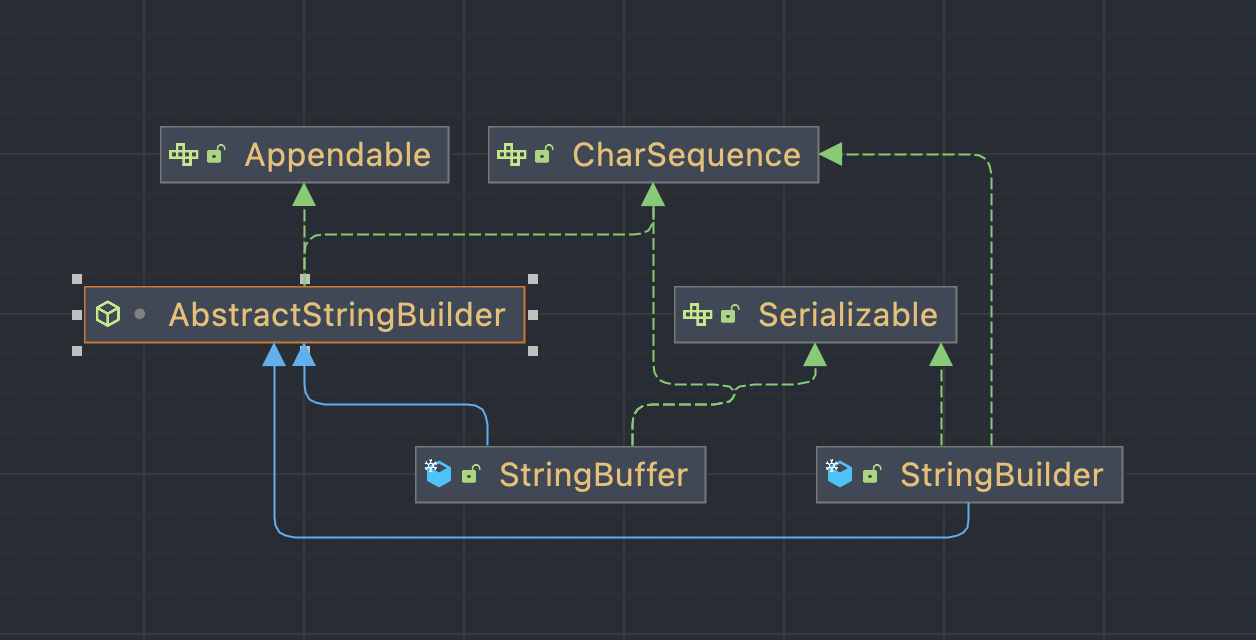前言
StringBuilder和StringBuilder都是字符串操作类。它们都继承了AbstractStringBuilder抽象类,并且都实现了CharSequence和Serializable接口。它们和String的区别在于它们的value数组没有被final修饰符修饰,所以是可变的。它们之间的区别是StringBuffer的方法是由synchronized关键字修饰,所以是线程安全的。

AbstractStringBuilder
AbstractStringBuilder是StringBuilder和StringBuffer共同继承的抽象类,它为子类提供了大部分的实现。
成员变量 & 构造方法
1
2
3
4
5
6
7
8
9
10
11
12
|
char[] value;
int count;
AbstractStringBuilder() {
}
AbstractStringBuilder(int capacity) {
value = new char[capacity];
}
|
扩容
1
2
3
4
5
6
7
8
9
10
11
12
13
14
15
16
17
18
19
20
21
22
23
24
25
26
27
28
29
30
31
32
33
34
35
36
37
38
39
40
41
42
43
|
public void ensureCapacity(int minimumCapacity) {
if (minimumCapacity > 0)
ensureCapacityInternal(minimumCapacity);
}
private void ensureCapacityInternal(int minimumCapacity) {
if (minimumCapacity - value.length > 0) {
value = Arrays.copyOf(value,
newCapacity(minimumCapacity));
}
}
private static final int MAX_ARRAY_SIZE = Integer.MAX_VALUE - 8;
private int newCapacity(int minCapacity) {
int newCapacity = (value.length << 1) + 2;
if (newCapacity - minCapacity < 0) {
newCapacity = minCapacity;
}
return (newCapacity <= 0 || MAX_ARRAY_SIZE - newCapacity < 0)
? hugeCapacity(minCapacity)
: newCapacity;
}
private int hugeCapacity(int minCapacity) {
if (Integer.MAX_VALUE - minCapacity < 0) {
throw new OutOfMemoryError();
}
return (minCapacity > MAX_ARRAY_SIZE)
? minCapacity : MAX_ARRAY_SIZE;
}
|
在一些虚拟机中会为数组保留一些 header words,所以为了防止OutOfMemoryError将MAX_ARRAY_SIZE设置为整型的最大值减 8。总的来说,扩容机制的过程如下:
- 新容量 = 旧容量 * 2 + 2,如果新容量仍然不能满足,数组长度直接设置为所需容量。
- 如果新容量小于
MAX_ARRAY_SIZE,直接返回新容量。
- 否则,当所需容量大于整型最大值时抛出异常。
- 如果所需容量 >
MAX_ARRAY_SIZE,直接返回所需容量,否则返回MAX_ARRAY_SIZE。
append()
append()是整个类的核心方法,拥有多个重载方法,这里主要分析以String为参数的方法。
1
2
3
4
5
6
7
8
9
10
11
12
13
14
15
16
17
18
19
20
21
22
23
24
25
26
| public AbstractStringBuilder append(String str) {
if (str == null)
return appendNull();
int len = str.length();
ensureCapacityInternal(count + len);
str.getChars(0, len, value, count);
count += len;
return this;
}
private AbstractStringBuilder appendNull() {
int c = count;
ensureCapacityInternal(c + 4);
final char[] value = this.value;
value[c++] = 'n';
value[c++] = 'u';
value[c++] = 'l';
value[c++] = 'l';
count = c;
return this;
}
|
StringBuilder
构造函数
1
2
3
4
5
6
7
8
9
10
11
12
13
14
15
16
17
18
19
20
21
|
public StringBuilder() {
super(16);
}
public StringBuilder(int capacity) {
super(capacity);
}
public StringBuilder(String str) {
super(str.length() + 16);
append(str);
}
public StringBuilder(CharSequence seq) {
this(seq.length() + 16);
append(seq);
}
|
append()
1
2
3
4
5
| @Override
public StringBuilder append(String str) {
super.append(str);
return this;
}
|
StringBuffer
方法实现基本和StringBuilder相同,但是被synchronized关键字修饰,保证了方法的线程安全。
以append()为例:
1
2
3
4
5
6
7
|
@Override
public synchronized StringBuffer append(String str) {
toStringCache = null;
super.append(str);
return this;
}
|
toStringCache & toString()
StringBuffer的任何写方法都会对toStringCache重设为null,该变量保存了最近一次toString()方法的缓存。
1
2
3
4
5
6
7
8
9
10
11
12
13
14
15
16
17
18
|
private transient char[] toStringCache;
@Override
public synchronized String toString() {
if (toStringCache == null) {
toStringCache = Arrays.copyOfRange(value, 0, count);
}
return new String(toStringCache, true);
}
String(char[] value, boolean share) {
this.value = value;
}
|
总结
- 可变性:
String是不可变的;StringBuilder和StringBuilder没有使用final和private关键字修饰底层的value数组。
- 线程安全性:
String对象是不可变的,线程安全;StringBuffer的写方法具有同步锁,线程安全;StringBuilder的写法发没有同步锁,线程不安全;
- 性能:
String类型改变时会生成一个新的String对象,并用指针指向它。StringBuffer每次对本身进行操作。- 相同情况使用
StringBuilder性能提高 10% ~ 15%,但是存在多线程不安全的风险。
- 使用:
String适合操作少量数据。StringBuilder适合单线程操作字符串缓冲区下操作大量数据。StringBuffer适合多线程操作字符串缓冲区下操作大量数据。
